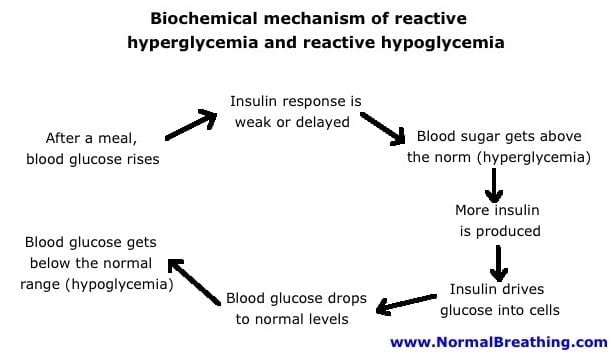- Updated on November 1, 2020
![]() By Dr. Artour Rakhimov, Alternative Health Educator and Author
By Dr. Artour Rakhimov, Alternative Health Educator and Author
How to improve blood glucose control (reactive hyperglycemia and hypoglycemia)
Two natural ways to achieve normal blood sugar regulation
Written by Chris Prokop based on his interview with Dr. Artour Rakhimov
Breathing techniques and diets are very powerful to restore normal blood glucose regulation and health of people with cancer, heart disease, HIV-AIDS, diabetes, asthma, COPD, epilepsy and many other chronic diseases. What are the best diets and what are the most effective breathing methods to stabilize blood sugar levels naturally and achieve normal health preventing these abnormal blood sugar reactions related to too high and too low levels of blood glucose after meals or due to chronically high blood glucose as in diabetes? In this video, Dr. Artour Rakhimov addresses the question of natural treatment, “How to improve blood glucose control and problems with reactive hyperglycemia and reactive hypoglycemia naturally?”
In this YouTube video interview, Dr. Artour Rakhimov explains how to improve blood sugar control naturally to treat problems with reactive hyperglycemia and reactive hypoglycemia:
Dr. Artour Rakhimov has personal experience with reactive hyperglycemia and reactive hypoglycemia over 15 years ago, in 2000. This experience is described below.
Insulin response and abnormal blood sugar control after a meal: biochemical mechanism of reactive hyperglycemia and reactive hypoglycemia
After a meal, especially breakfast, a person with reactive hyperglycemia will have continually rising blood sugar levels beyond the medical norm. That will often lead to a frequent need to urinate every 20 to 30 minutes. When blood sugar is 3-4 times above the norm the body releases it through the urine. People may also experience the opposite effect later, in about 10-30 minutes. Increased levels of insulin in the blood is going to cause reactive hypoglycemia where the sugar levels drop very low or below the normal range. At these moments of reactive hypoglycemia, people experience feeling cold, stressed, anxious and irritated. Doctors recommend having a snack at this time to provide you with energy from carbohydrates.
These steps can be described as following:
– After a meal, blood glucose rises
– Insulin response is weak or delayed
– Blood sugar gets above the norm (hyperglycemia)
– More insulin is produced
– Insulin drives glucose into cells
– Blood glucose drops to normal levels
– Blood glucose gets below the normal range (hypoglycemia).
The image below depicts these changes.

There are two methods that treat and cure reactive hyperglycemia and reactive hypoglycemia naturally. Using breathing exercises (Buteyko Method) and physical activity Dr. Rakhimov was able to completely eliminate the symptoms of both of them. Dr. Rakhimov breathed about 3-4 times more than the medical norm and his body oxygen test was 10 seconds. He tried to use low GI index foods and it only helped partially. When he improved his body oxygen test to 20 seconds he greatly decreased his hyperglycemia. While for his hypoglycemia he would feel much better and would only get mild headaches. Weeks later when he got 30 seconds for his CP (control pause) his sugar levels were just a little bit above the norm after breakfast and his hypoglycemia was gone.
Since then, he observed the same clinical picture in his students who also learned how to breathe in accordance with medical norms. The conclusion is following: with 40 to 50 seconds for the morning CP (body oxygen test result in seconds), people would hardly notice hyperglycemia symptoms because of only doing breathing exercises and changing their automatic breathing without any dietary changes. By regulating our breathing we can regulate blood sugar control naturally.
The second way of dealing with blood sugar control relates to changes in diet. Historically or from the evolutionary viewpoint, fat was used a lot more in our diet than carbohydrates (and sugars) as an energy source. There are much fewer changes in blood sugar levels when using fats. People willing to use stricter methods may adopt the therapeutic ketogenic diet that has less than 20 g of carbohydrates per day. The body then would use blood ketones (produced from fat) as the main energy source. Problems with blood glucose disappear because there is no blood glucose in the blood when not eating carbohydrates. Additionally, the insulin response disappears. In turn, reactive hyperglycemia and reactive hypoglycemia naturally vanish. This is done without any extra breathing retraining. Fruits, starches, bean, lentils are all taken out of the low carb diet, while meat, cheeses, eggs, greens and some vegetables are still allowed. In other diets, such as the Caveman diet, Atkins diet, and the Paleo diet, starches and grains are taken out too. This also improves blood glucose control problems. The optimum approach would be to use diet and breathing retraining together to achieve astonishing health benefits.
The Buteyko Breathing Method comes from Dr. KP Buteyko. He was a leading Soviet physiologist and doctor who discovered his breathing retraining method from observing the relation of hyperventilation and dying patients in hospitals. Dr. Buteyko noticed how hyperventilation worsened the symptoms of patients, including worsened blood sugar control in people with diabetes, and how breathing less eliminated their symptoms naturally normalizing blood glucose responses and insulin production and effectiveness. Likewise, in the West, doctors came to the similar conclusion about the relation of hyperventilation and how it increases the symptoms of sick patients. Dr. Buteyko also had personal experience with breathing less to get rid of his hypertension. Since his discovery, the Buteyko Method has been successfully used in clinical trials on a very extensive list of diseases.

